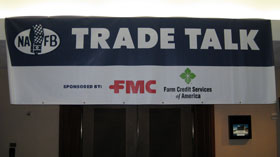 Precision guidance, autopilot and other precision agriculture technologies can give farmers yield advantages and input savings when implemented into certain cropping systems, said a Purdue University agronomist.
Precision guidance, autopilot and other precision agriculture technologies can give farmers yield advantages and input savings when implemented into certain cropping systems, said a Purdue University agronomist.
“Automatic guidance gives producers precision farming capabilities throughout the growing season by allowing them to map tillage operations and crop planting, spraying and harvest, and can help tailor fertilizer and chemical applications to avoid waste,” said Tony Vyn.
The most precise form of automatic guidance, real time kinematic, or RTK, is especially helpful to guide planting in strip-till corn systems. RTK guidance can help achieve precisely parallel strip-till passes in the fall or spring. The same guidance system can ensure the corn planter is centered on the strip-tilled berms, even if the planter is wider than the strip-till unit itself, and even if the berm positions are difficult to see in spring. Planting in the center of the berms helps achieve higher yields, especially in high-residue situations like corn after corn, Vyn said.
“When we’re talking about preplant nitrogen application in the form of urea ammonium nitrate (UAN) in either no-till or strip-till systems, precision guidance allows producers to plant corn either directly on top of the fertilized bands of the soil or at a precise distance away to reduce the risk of corn or seedling injury when higher UAN rates are applied,” Vyn said. “When preplant UAN exceeds 50 pounds per acre, it is safer to plant corn at least 4 to 5 inches to the side. This is another area where automatic guidance gives an advantage because it offers precisely parallel planting abilities.”
But automatic guidance isn’t the only precision agriculture technology that can increase producer efficiency. Take, for example, yield monitors, automatic planter row shut-off and automatic sprayer boom control.
Data from yield monitors can prove a need for tiling and show how it will pay off in specific fields. Both automatic planter row shut-off and sprayer boom control prevent overlap, and thus help producers improve the bottom line by decreasing waste.
The most important aspects of the advanced guidance and other precision technologies are more than just cost alone.
“Sometimes with precision technology, the challenge is for farmers to stay sufficiently alert in the tractor or the combine,” Vyn said. “Although automatic guidance helps farmers to work longer days, and although the improved ability to monitor implement functions helps farmers make fewer mistakes, the guidance technology is no substitute for doing all field operations with sound agronomy.”
When choosing an automatic guidance system, or any other precision technologies, there are a few tips Vyn said producers should keep in mind:
* Assess the farming operation before investing in precision agriculture tools. Decide what level of precision is needed for each field operation, both within a season and from year to year, and what financial benefits the technologies will bring to a specific cropping system.
- Make sure the system purchased has upgrade capability, as new technologies continue to come into the market.
- Less expensive systems won’t save producers as much as the higher quality guidance and monitoring systems.
- Review the compatibility of the precision technologies with the current equipment and planned replacement equipment.
- Look for a dealer with experienced precision farming technicians who can assist with any questions or issues producers may have.

 At the recent
At the recent 

 This edition of the Precision.AgWired.com Podcast features comments from the leaders of two precision technology companies that recently formed an alliance.
This edition of the Precision.AgWired.com Podcast features comments from the leaders of two precision technology companies that recently formed an alliance. 


